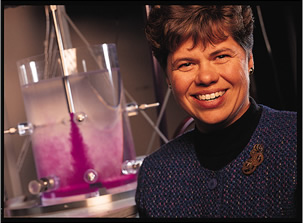|
BY NORDHAL FLAKSTAD
Freelance Writer
 |
|
An Expert
Mixer
Dr. Suzanne Kestra, P.Eng., stands before a less-than-perfect
mixing system. Surface feed, says the expert, is acceptable
for slow blending operations - but can reduce yield
in competitive-consecutive chemical reactions by up
to 20 per cent. Better to subsurface feed at the impeller,
says Dr. Kestra. That's the kind of wisdom imparted
in the book she helped edit, the Handbook of Industrial
Mixing.
|
Dr. Suzanne Kresta, P.Eng., admits to some mix-ups in preparing
what will likely become the bible of one of her areas of expertise
- industrial and chemical mixing.
The University of Alberta professor of chemical engineering
recalls some tense moments during her four years as corresponding
editor of the Handbook of Industrial Mixing. For instance,
there was the frantic call from a contributor in Freeport,
Tex., explaining that flooding from a hurricane had "drowned"
his computer and data. Fortunately there was a back-up.
In any case, it's now water under the bridge. September marks
the release of the 2,500-copy initial press run of the 1,450-page
tome, complete with more than 600 illustrations. Making the
book unique is that teams of academic and industrial practitioners
joined forces to write each of the 22 chapters covering best
practices on industrial mixing. The result is a what's-what
by the who's-who of mixing.
"Everyone who's anybody in the field has written a definitive
chapter. We have 44 contributors with a combination of more
than 1,000 years of mixing-engineering experience," says
Dr. Kresta, herself a leading expert on turbulent mixing.
She's also the recipient of both APEGGA's and the Canadian
Council of Professional Engineers' 1998 early accomplishment
awards.
Along with two American colleagues — veteran Merck
process development engineer Edward (Ed) L. Paul was senior
editor, and Victor Atiemo-Obeng of Dow Chemicals was industrial
editor — Dr. Kresta was part of the editorial trio
guiding this impressive project, sponsored by the North
American
Mixing Forum. DuPont Fellow Art Etchells, a member of the
forum of mixing experts, seeded the idea for such a handbook
almost a decade ago.
Bringing It All Together
While texts and many journals deal with industrial mixing,
the information is fragmented. There was a need to gather
theory and practice within one cover ¾ a notion embraced
by academia and industry alike.
A number of industries have much riding on the right mix.
Industries relying on effective and efficient mixing (of liquids,
slurries or even solids) are diverse. The list includes producers
of pharmaceuticals, chemical commodities, fertilizers, cosmetics,
food, pulp and paper, petrochemicals, and polymers. Add to
that processes such as water treatment and bioreaction that
depend on stirring.
Among industry's biggest challenges — be it drug manufacturers
measuring product in kilograms or chemical plants outputting
by the tonne ¾ is the leap from the laboratory bench
to huge industrial-scale vessels.
"Anyone can make a pizza for 10 people. But how about
for 10,000 people?" asks Dr. Kresta. "The problem
of scaling-up is very critical for chemical engineering."
Consistency and quality require careful balancing of variables
such as heat transfer, chemical reactions, solid suspensions
and gas dispersion. Plant designers and operators often face
the added challenge of using the same vessels for different
mixing procedures.
Tremendous strides have been made in the past half-century
as industrial mixing emerged as a bone-fide science and set
aside a reputation that sometimes stirred up images of a hit-and-miss
black art.
As mixing research progressed, academics documented their
findings. Although engineers and other industry practitioners
found workable solutions to specific mixing problems, once
an answer was in hand, they tended to move on. Often, this
meant that valuable insight remained uncaptured and unavailable
to someone with similar troubles.
The handbook, says Dr. Kresta, "brings together years
of plant and trouble-shooting experience."
Academia Meets Industry
An important editorial challenge lay in selecting the right
topics. With topics chosen, editors sought suitable pairing
of "town and gown" partners expert in specific fields,
and arranged meetings between them.
As corresponding editor, Dr. Kresta became facilitator, go-between,
diplomat and sometimes cajoler pushing the process forward.
Her co-editors readily acknowledge her enormous contributions.
Victor Atiemo-Obeng is "completely convinced we are
where we are with this project to-date because of her complete
belief in the project, her technical contributions, her tireless
effort in diplomatically addressing sticky and thorny issues
that emerged, and her tenacity in keeping the project moving
toward the target."
Says senior editor Ed Paul: "Her technical expertise
was demonstrated both in being a co-author of two excellent
chapters as well as by her ability to bring critical technical
editorial input to the authors of virtually all of the other
chapters, thereby serving as an expert internal reviewer and
editor."
Face-to-face meetings proved important, but e-mail provided
the sustaining lifeline for this ambitious project, which
Dr. Kresta pursued while maintaining her considerable teaching
and research load. Her computer became an electronic Grand
Central as e-mails sped in from as far away as the Antarctic.
"Nothing arrived as hardcopy in my mailbox; everything
arrived in my e-mail box."
So why not also publish electronically? That option was considered,
Dr. Kresta concedes. However, it was decided there were advantages
in printing at least the first edition. It lets the publication
benefit from the distribution network and profile of a recognized
and well-established publisher, John Wiley.
While a Web-based version would allow cross-linking, editors
thought a print version better exposed readers to the book's
collaborative approach. A CD-ROM that comes with the handbook
provides video illustrations of many mixing processes, however,
and it wouldn't surprise Dr. Kresta if a follow-up edition
were published electronically.
Until then, expect to see the new handbook in many industry
libraries and on desks in consulting, design and processing
firms.
"It should be accessible to any chemical engineering
operation with more than 15 engineers," suggests Dr.
Kresta.
If that recommendation is heeded, it bodes well for sales
of the Handbook of Industrial Mixing.

MORE INFO
Dr. Suzanne Kresta, P.Eng.
suzanne.kresta@ualberta.ca

|



